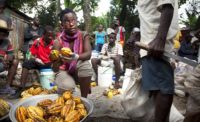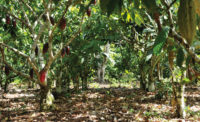Gianluca Franzoni, president and founder of Domori, smiles easily when referencing some of the titles that have been associated with his passion for cacao and chocolate.
“In Venezuela, they called me ‘The Hidalgo of Cacao[Editor’s note: Hidalgo is a Spanish reference to nobility; it literally means son of something]; in the United States, the Shaman of Cacao while in Japan I’m known as the First Sommelier of Cacao,” he says. It’s clear that the 47-year Italian entrepreneur doesn’t mind the designations; after all, it simply describes his passion for what has become a way of life.
A self-professed foodie — “Since I was a kid, I was into food and wine,” he says — Franzoni found his true calling when he opted to travel to Venezuela in 1993 as an ambitious environmentalist looking to sell water treatment plants with a good friend of his. Although that plan didn’t quite work out, the trip literally opened a New World for him.
In betwixt managing a restaurant and teaching tennis, his sense of adventure led him to visiting cacao plantations and exploring the essence of chocolate.
As he writes in his book, Finding the Lost Chocolate, “My adventure in cocoa plantations started in 1993. The year after I took up the challenge, I wandered from the East to the West trying to understand...the first times I fermented a few fistfuls of cocoa without any result. I roasted the different varietals in usual pans...I ground cocoa beans in the mincer. I slept on a bed of dew and fed on the wind...but maybe it was my karma...to turn a stormy ocean into a tidy garden… I am just a humble server of cacao, and this is my real mission: to help flavor cacao change its history.”
During the next three years, Franzoni meticulously investigated the science behind cacao beans and producing chocolate. In his kitchen, he experimented with various cacao beans to personally experience the nuances of flavor and process.
Upon returning to Italy in 1996, he worked on the finishing touches of a business plan, one that merged sourcing with sales.
“Typically, there is no identity between grower and processor,” he explains. “A midsized chocolate company that’s processing about 10,000 tons of cocoa beans would require 20,000 hectares of cocoa fields. That doesn’t happen. These companies deal with traders. As a result, there’s no culture of cultivation.”
The same applies to growers, Franzoni continues. “The cocoa farmers are looking to survive, to make a living. There’s no idea of tasting or selecting the right bean.”
To Franzoni, it was clear that his mission was to bridge that gap and personally establish a relationship between the bean and the bar. Given his food pedigree, it was also clear that Franzoni wouldn’t settle for just any cacao beans; they would have to be the best.
In general, fine flavor beans consist of the Criollo, Trinitaro and Nacional varieties. Of those three, Criollo is the rarest bean available, accounting for less than 0.001% of all beans grown in the world.
During Franzoni’s time in Venezuela, he had established contacts with various cacao plantations. In doing so, he eventually forged a joint venture with Hacienda San Jose Plantation. That connection led to an active effort to foster growth of Criollo varieties on the plantation through the use of hybrids. The results led to recognition by some of the leading cacao authorities, making it a pioneer in cacao bean husbandry — a role that still continues today.
Back in Italy, he focused his efforts on developing recipes and marketing the fledgling company. Finding existing companies to process a mere 5,000 to 6,000 lbs. of cocoa proved challenging until he teamed up with a small facility in Italy that produced only private label products.
In the interim, Franzoni relentlessly pursued retailers and agents to handle a chocolate that he believed was exceptional in origin, flavor and purity. He also singlehandedly pioneered several firsts in the world of chocolate:development of a tasting "code" for fine flavor chocolates; creation of products solely from flavor aromatic cacao types from several countries; and production of a 100% cocoa mass chocolate bar for enjoyment alone. Up until then, unsweetened chocolate was made for cooking or blending purposes.
By 2002, sales had reached the point where Franzoni found financial support to invest in building his own manufacturing facility. The 4,000-sq.-meter facility in None, Italy, set the stage for Franzoni’s continued pursuit of producing the world’s best chocolate.
“Seventy-five percent of a fine chocolate’s value lies with genetics, post-harvesting techniques,” he says. “The remaining 25% belongs to processing. You can’t change the value of the raw material.”
Having committed himself to using only the finest of beans — the company took over management of the Hacienda San Jose plantation in 2004 — Franzoni applied the same intensity and intellect toward finding the right processing technology.
“I wanted my facility to share the same vision that I have in the field, which is to maintain all the potential of the cacao,” he says. “The processing would have to be a low-impact one on the cacao.”
It would also have to be innovative and flexible. “We had no prejudices about technology; we wanted to keep an open mind,” Franzoni adds.
From roasting to conching, it was all about retaining the flavor of the bean. Having used ball mills for grinding and refining in the past for small volumes, thereby preserving the cacao’s essence, he was adamant about using technology to attain the same goal for larger volumes.
Franzoni founded kindred spirits in his quest for preserving the quality of cacao: Bruno Porro, managing director of Tecno-3, and Pierangelo Pagliotti, the 1994 European Candy Kettle Award winner from Elah-Dufour and now a consultant for Tecno-3, shared his vision in preserving flavor traits through innovative technology.
He also found a kindred patron in Italian coffee giant, illycaffè, which bought a 90% share of Domori in 2006. That acquisition enabled Franzoni to focus on the improving the processing of beans at the facility as well as enhancing Domori’s image.
His association with Porro and Pagliotti led to the development and installation of a three-phase refining and liquid conching process that proved critical in addressing both quality and flexibility issues for the company, particularly as it expanded into wholesaling with the introduction of its Labo line of couvertures (See Supplier Spotlight article on p. xxx)
“We needed good homogeneity, plasticity and elasticity; it would have to be friendly to the end users,” he says. “Consequently, we needed to invest in a different process.”
With 15 different types of couvertures (10 in dark chocolate including four single origins and one Criollo; four milk chocolate and one white chocolate), Domori offers a broad range of chocolates for nearly every chocolatier’s or chocolate company’s needs.
In a short 16 months, the company went from producing 40 tons of couvertures to 300 tons annually.
“The capacity of the line is 1,500 tons, and we’d like to achieve that in five years,” Franzoni says.
Currently, the business-to-business side represents 80% of the company’s total revenues, which hit €10 million last year. Retail sales account for the remainder, with exports and domestic (Italy) sales equally split.
On the retail side, Franzoni redesigned the packaging. He retained the traditional burgundy color, but streamlined the design to portray elegance, elements prevalent in the fragrance and fashion worlds.
“Our retail products are well-positioned in Japan and France, “ Franzoni says. He also sees additional potential in the United States as well, particularly with the company’s Labo line of couvertures. There’s also a push to double the company’s retail presence in Italy, from 1,500 to 3,000 retail shops carrying the product line.
In addition, Franzoni is looking to introduce pralines to the Domori retail line, which includes 25-g. bars featuring Criollo beans, single origins, infused flavors, gianduja and a range of specialty and gift items, which includes dragees and drinking chocolate.
The pralines will be special, he guarantees. “There’s no room for an average product.”
If current projections hold, however, there may not be enough room for additional capacity at the plant. Franzoni says he has already begun looking at sites in anticipation of future growth.
In the end, his mission won’t waver.
“I look at working with chocolate similar to being a winemaker. I simply want to enhance the potential that is in the field.”
Domori
Headquarters: None, Italy
Sales: €10 million (2012)
Plant: 4,000 sq. meters
Employees: 40
Products: Single –origin bars from cru chocolate, flavor-infused bars with nuts, spices and nibs, dragees, specialty items, bulk couvertures.















